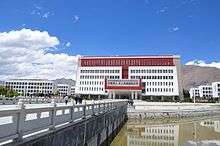Tibet University
|
西藏大学 | |
 | |
| Motto | 团结,勤奋,求实,创新 |
|---|---|
Motto in English | United, Diligent, Realistic, Innovative |
| Type | Public university |
| Established | 1985 |
| President | Ji Jianzhou (纪建洲) |
| Party Secretary | Nima Tsering (尼玛次仁) |
Administrative staff | 1,100 |
| Students | 28,000 |
| Undergraduates | 9,417 |
| Postgraduates | 600 |
| Location |
Lhasa and Nyingchi, Tibet, |
| Campus | Urban, 2 campuses |
| Tibet University | |||||||
| Chinese name | |||||||
|---|---|---|---|---|---|---|---|
| Simplified Chinese | 西藏大学 | ||||||
| Traditional Chinese | 西藏大學 | ||||||
| |||||||
| Tibetan name | |||||||
| Tibetan | བོད་ལྗོངས་སློབ་གྲྭ་ཆེན་མོ་ | ||||||
| |||||||
Tibet University is a provincial research university and the largest university in the Tibet Autonomous Region of China. With an internationally renown Department of Tibetan Studies and a majority ethnic Tibetan student body, the university maintains a focus on local communities and cultures.
The school has two campuses, in Lhasa and in Nyingchi.
In September 2017, Tibet University was reocgnized as a Chinese Ministry of Education Double First Class Discipline University, with Double First Class status in certain disciplines.[1]
History
The precursor to Tibet University were informal classes established by Tibetan cadres in 1951.[2]
In May 1983, the State Council of the People's Republic of China officially approved to established the University of Tibet in the basis of the existing Teachers College in Lhasa. Tibet University was formally established on July 20, 1985.
Since 1999, various institutions of higher education, including the art school of the Tibet Autonomous Region, the Tibet Medical College, the Medical Department of the Tibet Institute for Nationalities and the Tibet Autonomous Region Finance School have all been incorporated into Tibet University, giving it a more rounded profile of academic departments.
In December 2008, Tibet University was selected as a beneficiary of the national Project 211. In 2017, the university was included by the Ministry of Education in the Double First Class University Plan, with Double First Class status in certain disciplines.
Student life

About 7,500 students are enrolled at the university. Nearly 20% of students study in the renowned Department of Tibetan Studies, which draws international students as well as locals, although the majority of instruction is delivered in Han Chinese.[3]
Tibetan language study is mandatory at Tibet University.[4]
As of 1995, 92% of the university's students are from ethnic minority groups, though ethnic Tibetans form only 67% of the student body and other groups of ethnic minorities have a significant presence.
Administration
Lhasa campus of the existing staff of 863 people which includes 523 full-time teachers. Out of the 523 teachers, 327 are Tibetan, accounting for 62.5%. There are approximately 14,020 students.
The school has 11 colleges: Faculty of Arts, Science, Engineering, Agronomy, College of Medicine, School of Economics and Management, School of Tourism and Foreign Languages, Arts, Teachers College, School of Continuing Education, the Central Radio and TV Tibet Institute.
Programs
The university and the government has been criticized for the university's lack of degrees focusing on social studies and the arts, which are needed to preserve, enhance, and recover indigenous Tibetan traditions, values, and way of life.
- Bachelor's Degree
- Electronic and Information Engineering
- International Economics and Trade
- Chemical Engineering and Technology
- Environment and Energy
- Software Engineering
- Communication Engineering
- Pharmaceutical Science
- Master's Degree
- Business Administration (Specializing in International Trade)
- Chemical Engineering and Technology
- Mechanical Manufacture and Automation
- Computer Software and Theory
- Non-degree Offers
- International Summer Camp (3 weeks on Chinese studies)
References
- ↑ "教育部 财政部 国家发展改革委 关于公布世界一流大学和一流学科建设高校及建设 学科名单的通知 (Notice from the Ministry of Education and other national governmental departments announcing the list of double first class universities and disciplines)".
- ↑ Zhang, Cheryl (2008-11-12). "Tibet University witnesses to development of TAR education". China Tibet Information Center. Archived from the original on 2011-07-21. Retrieved 2010-11-19.
- ↑ "Tibet University World's Biggest Cradle of Tibetan Studies". Xinhua. 2004-06-14. Archived from the original on 2010-11-21. Retrieved 2010-11-19.
- ↑ "University Launches Degree Exams on Tibetan Language". People's Daily. 2002-04-27. Archived from the original on 2011-09-29. Retrieved 2011-08-15.
External links
- Tibet University official website in (in Chinese)
Coordinates: 29°38′45″N 91°08′43″E / 29.64590°N 91.14541°E